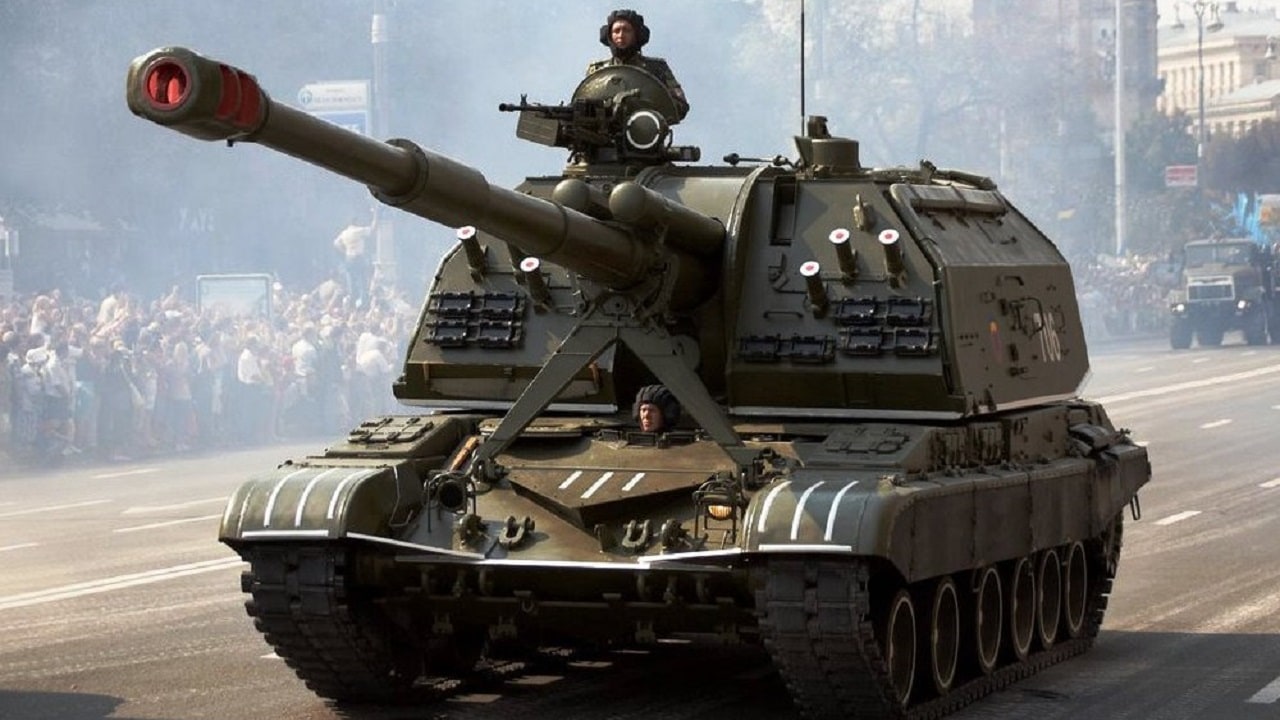As Russian forces continue to wage their invasion of Ukraine and make incremental advances in Donbas, the role of Russian artillery has never been more significant. Russian massive employment of artillery fires to facilitate its advance and Ukraine’s use of (HIMARS) to strike targets far behind Russian lines has shown how crucial modern artillery arsenals are in modern interstate warfare.
Although Russia’s most modern artillery weapon in service today is the 2S35 Koalitsiya-SV (Coalition-SV), it appears to be entirely absent from combat thus far in Russia’s invasion.
What is the Koalitsiya?
At its core, the 2S35 Koalitsiya-SV is an updated version of Russia’s heavily-employed 2S19 Msta self-propelled howitzer. Even though the Koalitsiya is supposed to be built on the Armata Universal Combat Platform, the first versions of the tank unveiled at the 2015 Moscow Victory Day parade appeared to be built on the same chassis as the Msta, which includes elements of the T-72 and T-80.
The 2S35 Koalitsiya-SV’s principal armament is its 152mm 2A88 main gun. Crewed by a driver, commander, and gunner, the Koalitsiya can fire a wide range of munitions, including precision-guided, rocket-assisted, and high-explosive rounds. These include the Krasnopol guided shell, which is one of the most accurate artillery munitions in Russia’s arsenal. Additionally, armed with a 12.7mm Kord machine gun, the Koalitsiya is outfitted with nuclear, biological, and chemical protection and has night-vision optics.
Development of the Koalitsiya
Development of the 2S35 Koalitsiya-SV officially began in 2006, although the armed forces had been considering developing such a system shortly after the collapse of the Soviet Union in 1991. The Koalitsiya was initially developed by the Burevestnik Central Scientific Research Institute, while manufacturing was handled by the Ural Transport Engineering Plant (known as by its Russian portmanteau Uraltransmash).
The first Russian Koalitsiya-SVs were delivered to the Russian armed forces in May 2020, after which they began operational trials. In 2021, Russian state media sources claimed that the system had been tested in “flurry of fire” mode, which was described as the firing of shells at timed frequencies and ballistic trajectories to cause all six shells to strike a target at the exact moment, a claim which is difficult to verify.
What Service has the Koalitsiya Seen to Date?
While those same Russian state media sources have also claimed that the Koalitisiya-SV’s reported maximum range of 70 kilometers allows it to outrange standard Western artillery systems, the Koalitsiya-SV has not had any confirmed use in Ukraine. If it were to be used, the Koalitisiya would find its match in Ukraine’s HIMARS launchers, which are capable of firing rockets with ranges of 70 or more kilometers, with the ability to fire the even longer-ranged ATACMS rockets (which Ukraine has requested but is yet to receive).
Like its T-14 Armata cousin, Moscow is possibly hesitant to deploy the 2S35 Koalitsiya-SV to the battlefields of Ukraine for fear of losing some of its most new and advanced kit or risking possible poor performance by the system in battle.
With its reportedly significant capabilities, Russia’s reluctance to deploy its 2S35 Koalitsiya-SVs to fight in Ukraine runs contrary to Russia’s hype for the weapon as a game-changing new advantage to be enjoyed by Russia’s Ground Forces. Limited information on the actual quantity of the system held by Russia also obscures a possible reason for why the system is yet to see combat service while older systems such as the Msta, which the Koalitsiya was designed to replace, form the backbone of Russia’s artillery war in Donbas.
That said, its current absence from Ukraine does not ensure that it will never reach combat there, as future battlefield requirements may result in the Koalitsiya’s use after all.
Wesley Culp is a Research Fellow at the Center for the Study of the Presidency and Congress. He regularly writes on Russian and Eurasian leadership and national security topics and has been published in The Hill as well as in the Diplomatic Courier. He can be found on Twitter @WesleyJCulp.

